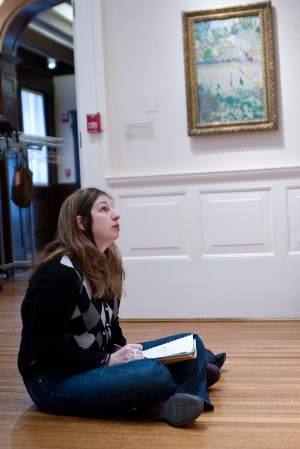Since 2005, The Phillips Collection has solicited k-12 educators to be part of the museum’s Mentor Teacher Program, which enables best-practice school teachers to partner with the Phillips to produce and publish inventive lessons that weave museum artwork and visual arts learning into school curriculum. This past Monday, the museum hosted 45 teachers from Stafford Elementary School in Northern Virginia. The museum experience was a professional day dedicated to learning how art can inspire learning across the curriculum. Led by a four-person cross-curricular teaching team who first worked with the museum in 2006, teachers created watercolors that combined artistic imagination and scientific observation, made sketches in the galleries, and learned how to integrate the teaching of math, social studies, and language arts into studying and creating visual art.
Tag Archives: education
Teaching through the Prism: What Does Arts Integration Look Like?
This is the second installment in the Teaching through the Prism series, anticipating our upcoming national forum on Arts Integration, June 23−24. Read Suzanne’s first post here.
Next week at our Teaching through the Prism of Arts Integration Forum, we’ll be screening a brand new video featuring our year-long project, Teach with O’Keeffe, working with art museums and classroom teachers from New York to New Mexico, and of course Washington, DC. Seeing the experiences of the students (“If I have a connection to something visual… then I will enjoy it,”), teachers (“Arts Integration peaks student interest,”) and administrators (“I believe that art brings out critical thinking,”) emphasizes what we’ve noticed about the impact of arts across the curriculum: it encourages innovative teaching, deepens personalized learning, promotes learning through multiple learning styles, and advances 21st century skills such as creativity, critical thinking and problem solving.
My favorite line of the movie: Erin Fitzgerald, a middle-school language arts teacher from New York City says, “Arts Integration. It’s not an add-on!” She really knocks it out!
Suzanne Wright, Director of Education
Teaching through the Prism: Who Got Science in My Art?
This is the first installment in the Teaching through the Prism series, anticipating our upcoming national forum on Arts Integration, June 23−24. Learn more here.

Third grade student at Turquoise Trail Charter School in New Mexico studies the details of a rock that she will synthesize into a series of abstract artworks, part of a project blending art and geology curricula. Photos: Lynn Grimes
Many of us find that chocolate mixed with peanut butter is pure joy. What if art is our chocolate? And K−12 education—language arts, math, science, social studies—is the peanut butter? What happens when you blend them? Curious?
Case in point: this young girl using a jeweler’s loupe at Turquoise Trail Charter School in New Mexico, one of our national partnership schools. She uses the loupe to carefully observe a rock’s size, texture, color, and weight, recording her observations as a geologist would. She is asked to scrutinize even harder, following Georgia O’Keeffe’s call to look closely at the overlooked. Then she applies O’Keeffe’s principles of “selection, elimination, and emphasis” to synthesize her scientific drawings into an original abstract artwork.
Want to impress your friends with your education reform prowess? Talk about the power of “arts integration,” this mix of art and other curricula, to engage students and teachers. Need to back up the touchy-feely with facts? Browse through the President’s hot new report on the benefits of arts integration.
Suzanne Wright, Director of Education



